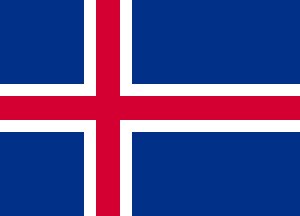
| Colors | HEX Code | RGB | CMYK |
|---|---|---|---|
| Sky Blue | #003087 | 0, 48, 135 | 100, 64, 0, 47 |
| Fire Red | #D50032 | 213, 0, 50 | 0, 100, 77, 16 |
| Snow White | #FFFFFF | 255, 255, 255 | 0, 0, 0, 0 |
The Flag of Iceland has a sky-blue field with a snow-white Nordic cross and a fiery red cross on the white cross. The width of the red cross is 1/9 of the width of the flag, and the white stripes are half as wide, or 1/18 of the width of the flag.
Meaning of the Icelandic Flag
The blue color represents the Icelandic sky and the surrounding atlantic ocean waters. The white color represents the snow and ice. The red color represents fire and the volcanic nature under Iceland’s surface. The island is said to be created from these three elements. The combination of the colors blue and white with red shows historical links with Norway. The use of the Nordic cross reflects Iceland’s close ties with the other Nordic countries.
History of the Icelandic Flag
Iceland was part of Denmark, then it sought independence in the 19th century, a suggested national emblem of Iceland was a white falcon on a blue field. The need for a flag emerged as a part of its independence campaign.in 1885, the Icelanders called for a national flag, and several proposals were made, which all agreed on blue, red, and white. The current flag with a blue background and white and red crosses was designed by Matthias Thordarson and Einar Benediktsson. It was made official in 1915 by a royal decree.